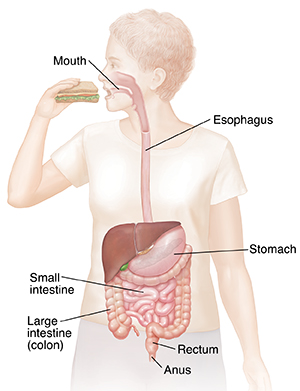The Digestive System: An Overview
What is digestion?
Food and drink must be changed into smaller molecules of nutrients to be absorbed into the blood and carried to cells throughout the body. Digestion is the process by which food and liquid are broken down into smaller parts. The body can then use them to build and nourish cells and to make energy.
How does the digestive process work?
Digestion involves:
Digestion begins in the mouth, where food and liquids are taken in. It's completed in the small intestine.
What is included in the digestive system?
The digestive system is made up of the digestive tract and other organs that aid in digestion.
The digestive tract is a series of hollow organs joined in a long, twisting tube from the mouth to the anus. It consists of the following:

Organs that help with digestion, but are not part of the digestive tract, are the:
Parts of other organ systems, such as nerves and blood, also play a major role in the digestive process.
How does food move through the digestive system?
Muscles propel food and liquid along the digestive tract in a wave-like movement. This movement is called peristalsis. In general, there are 6 steps in the process of moving food and liquid through the digestive system:
-
The first step in the digestive process occurs in the mouth. This is where food is chewed and broken down into a size that can be safely swallowed. The start of swallowing food or liquid is voluntary. But once it begins, the process becomes involuntary and continues under the control of the nerves.
-
The esophagus connects the throat above with the stomach below. It's the first organ into which the swallowed food goes.
-
Where the esophagus and stomach join, there is a ring-like valve that closes the passage between the 2 organs. When food nears the closed ring, the surrounding muscles relax and allow the food to pass into the stomach. It then closes again.
-
The food then enters the stomach. The stomach completes 3 mechanical tasks. It stores, mixes, and empties:
-
First, the stomach stores the swallowed food and liquid. This needs the muscle of the upper part of the stomach to relax and accept large volumes of swallowed material.
-
Second, the lower part of the stomach mixes up the food, liquid, and digestive juices made by the stomach through muscle action.
-
Third, the stomach empties the contents into the small intestine.
-
The food is digested in the small intestine. It's dissolved by the juices from the pancreas, liver, and intestine. The contents of the intestine are mixed and pushed forward to allow further digestion.
-
Last, the digested nutrients are absorbed through the intestinal walls. The waste products, including undigested parts of the food (fiber) and older cells that have been shed from the lining of the intestine (mucosa), move into the colon. Waste products in the colon often remain for a day or two until the feces are expelled by a bowel movement.